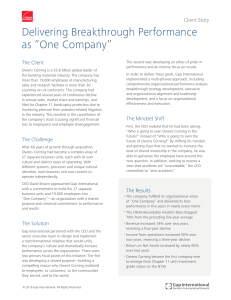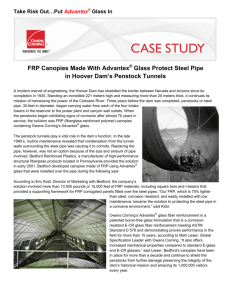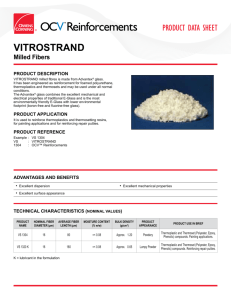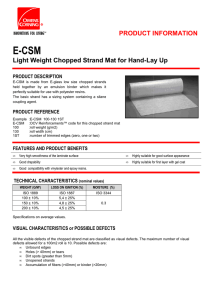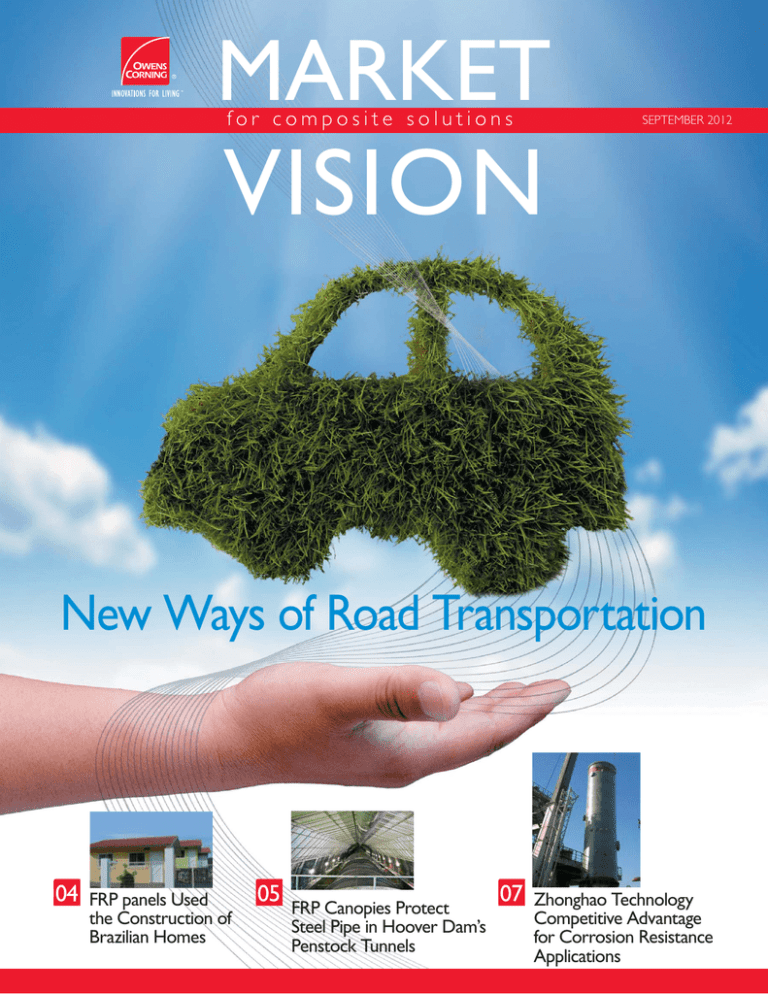
MARKET
for composite solutions
SEPTEMBER 2012
VISION
New Ways of Road Transportation
04
FRP panels Used
the Construction of
Brazilian Homes
05
FRP Canopies Protect
Steel Pipe in Hoover Dam’s
Penstock Tunnels
07
Zhonghao Technology
Competitive Advantage
for Corrosion Resistance
Applications
E D I TO R I A L
NEW WAYS OF
ROAD TRANSPORTATION
"If you took all the composite parts off a (sport) car today, it probably wouldn’t stay on
the track" said Rusty Wallace, a former NASCAR driver at COMPOSITES 2012.
One of the most significant global challenges we face is balancing the need for
automobiles and personal transportation with the stress that present technology
places on energy consumption and global warming. The global car production output
is expected to increase 6%8 with Brazil, Russia, India, and China accounting for 30% of
world auto sales in the 20149. Obviously creative solutions are needed to reduce this
market consumption of nearly one-third of all global energy7.
The need for lighter-weight vehicles for energy reduction and sustainability is
compelling. For every 100 pounds of weight a vehicle carries, there is a 2% reduction
of gas mileage performance10. While more than two-thirds of a car’s weight is steel, kilo
of composites in a car vary from 3 (China) to 12 (Europe)14. With a typical composite
part weighing 25% to 35% less than conventional materials13, composites can be a
major contribution to more efficient, sustainable vehicles.
Owens Corning was there when the first composite auto body was introduced in
1953 and remains a leader in developing solutions to support less energy intensive
trends in the global automotive market. Since the 1970’s, we have seen a dramatic
rise in the use of thermoplastic materials in vehicles. This has enabled the replacement
of metal for weight reduction, through design flexibility and function integration.
By partnering with our customers who represent some of the leading automobile
suppliers and manufacturers, we play a key role in developing reinforcement
technologies for a broad range of thermoplastic resins from PP to PEEK. Today, Owens
Corning offers the widest selection of products to meet the market need for each
resin type.
More recently we have seen the development of solutions using longer reinforcement
structures (eg. LFT using PP resins). In the future, we expect this trend to develop
with the move towards continuous fiber solutions marrying both reinforcement
technologies with fabrication technologies. Complex reinforcement structures will
enable even greater penetration of thermoplastics into automotive applications.
Owens Corning is committed to supporting its customers’ technological demands
throughout the world. Our new Shanghai China Composite Center is our most
recent example of adding to the power of our application support by having dedicated
resources and capabilities in one of the fastest growing markets for automotive
manufacturing.
The composites industry can be a leader in developing next generation solutions
that enable the continued adoption of lighter, more efficient and cleaner vehicles.
This trend will benefit the transportation of societies and our planet.
Let’s work together and reach this goal.
Sincerely,
Arnaud Genis
Group President
Owens Corning Composite Solutions Business
FIGURES ARE TELLING
• Only about 14%-26% of the energy from the fuel
you put in your tank gets used to move your car down
the road1.
• 16% of global man-made CO2 emissions results
from road transport15.
• In the USA, $4 per gallon gas prices could result in an
additional 670 million public transit passenger trips2.
• China aims to reduce fuel consumption to 4.5 liters
per 100 kilometers by 20203.
• There were 14.8 million natural gas vehicles
by 201111, i.e. less than 1% of the world’s road fuel
consumption12.
• A Stanford University research team has a longterm goal to develop an all-electric highway that
wirelessly charges cars and trucks as they cruise down
the road4.
• 70% of cars sold in Europe in 2015 will use the
new Start-Stop technology that improves fuel
economy5.
• Engineers at Mahindra & Mahindra are taking on a
nearly impossible challenge: to build a new sports utility
vehicle that weighs less than one ton instead of the
1,600-2,000 kg currently6.
1
2
3
4
5
- http://www.fueleconomy.gov/feg/atv.shtml
- http://transportation.nationaljournal.com/2011/03/theimpact-of-high-gas-prices.php
- PLASTICS NEWS CHINA
- ScienceDaily (Feb. 1, 2012)
- http://www.johnsoncontrols.com/publish/us/news and http://www.jsonline.com,
May 2012
6 - The Economic Times, Oct. 2011
7 - Lux Research (Boston, MA), 2012, Structural Navigation: Optimizing Materials Selection
in Automotive and Aerospace.
8 - CSM Auto Global Insights, February 2012
9 - Winning the BRIC Auto Markets BCG.pdf_The Boston Consulting Group, Inc., 2010
10 - http://www.ecofriend.com/entry/5-efficient-plug-hybrid-vehicles-helping-save-fuel/
11 - Worldwide NGV Statistics. NGV Journal. Retrieved 2012-04-24.
12 - The Contribution of NGV to Sustainable Transport.pdf – Intl Energy Agency
Michiel Nijboer – 2010
13 - Scientific American Magazine and Ward’s Automotive Yearbook
14 - CSM Auto Global Insights, February 2012
15 - International Organization for Motor Vehicle Manufacturers OICA – 2008
E L E C T R I C A L
&
E L E C T R O N I C S
Poles Offer Sustainable
Light Solution for All in Brazil
Brazil’ss Light for All Program was launched
d
in 2003 and has provided electricity to
approximately 12 million people or almost 3
million homes. Despite success, expanding the
program to include those who live in forested
or mountainous areas with little to no access to
roads presents new challenges.
Necessity, however, often brings technological
innovation. Combine the need for electricity with
Owens Corning’s innovation promoting the use of
fiberglass reinforced polyester materials in light poles,
and a sustainable solution is achieved. The fiberglass
reinforced materials are produced at Owens
Corning’s facility in Rio Claro-SP, Brazil, with the
poles being manufactured in Manaus.
Eduardo Giardi, Operations Director of Brazilian
power distributor AES Sul, stated to the Brazilian
press the company is constantly searching for
new technologies and supports the widespread
use of the fiberglass poles. “Since the fiberglass
poles are more flexible than concrete and metallic
structures, they weather storms better and, because
the fiberglass poles do not corrode, significantly
less maintenance is required compared to other
structures“ Said Giardi.
Since the poles do not conduct electricity, they
are safer to install, and using fiberglass reinforced
materials can reduce construction time and total
costs.
According to technical experts within Owens Corning,
another advantage of the fiberglass poles is that each
weighs just over 100 kilograms; conventional poles can
weigh ten times this much.
Because the fiberglass poles are
considerably lighter, they are more easily
transported to isolated locations by helicopters,
canoes, pack animals, and even people.
These poles are also a solution for heavily
populated areas and inner cities where access by
large equipment is limited.
The Light for All Program has captured the
attention of many countries including Latin
America, Africa and Asia, and discussions are
underway to create similar programs in these
and other countries. The program has been so
well received, the United Nations is using it as a
case study on how electricity can be provided to
brighten the lives of millions more people around
the world.
For more information, please contact Owens Corning
Customer Service in Brazil at 0800 707 3312
Transforming the World with Advanced Solutions
3
C
O
N
S
T
R U
C
T
I
O
N
Courtesy MVC Soluções em Plásticos, Brazil
FRP panels Used in the Construction
of Brazilian Homes
When the Brazilian Federal Government
launched the Minha Casa, Minha Vida (My
House, My Life) program in March 2009,
a number of companies were selected to
build homes for low income families.
One such company was MVC, a leader
in developing products and solutions
for engineering plastics. And, MVC’s
innovation was to use fiberglass-reinforced
polymer (FRP) in wall panels being
installed in the homes.
MVC in partnership with M. Rocha, a
Brazilian construction company, is supplying
436 houses that are being built in the
municipality of Japeri in Rio de Janeiro.
MVC was chosen to participate in this
project because of its innovative and
sustainable high quality building solutions
that offer advantages over conventional
processes according to the company.
Their solutions for these homes use an
innovative “wall system” that comprises
a metallic structure and wafer-like panels
made of FRP sheets similar to those used
in airplanes and boats. The sheets are used
along with expanded polystyrene and a
hard gypsum core.
According to MVC, its composite system has
the advantages of reduced construction time, higher strength
materials offering longer durability.
4
“The composite system also offers
thermal and acoustical comfort, and
no waste over traditional systems of
masonry construction using bricks and
mortar.” The wall panels are provided
to the site painted and with electrical
and hydro-sanitary systems already built
into the walls, which reduces costs and
construction time.
Construction of the houses began in
May 2012 and will be completed in
December of this year. The first houses
were available for occupancy in May.
The units are approximately 37.8m2 and
include a kitchen, living room, bathroom,
two bedrooms, laundry, and service area.
Gilmar Lima, General Director of MVC,
stresses that the housing project in Japeri
is an example of housing worthy of use
throughout the whole country.
“We are very proud to be part of this
project that brings high quality homes to
the people, using advanced construction
standards even in remote areas of Brazil”,
said Ricardo Grizzo, Owens Corning´s VP
for Latin America.
For more information please visit
www.mvcplasticos.com.br/noticias.php
Transforming the World with Advanced Solutions
W A T E R
D I S T R I B U T I O N
FRP Canopies Protect
Steel Pipe in Hoover
Dam’s Penstock Tunnels
A modern marvel of engineering, the
Hoover Dam has straddled the border
between Nevada and Arizona since its
completion in 1935.
Replacing the pipe, however, was not an
option because of the size and amount of
pipe involved. Bedford Reinforced Plastics, a
manufacturer of high-performance structural
fiberglass products located in Pennsylvania
provided the solution in early 2001. Bedford
developed canopies made of FRP using
Advantex® glass that were installed over the
pipe during the following year.
Courtesy Bedford Reinforced Plastics, USA
According to Eric Kidd, Director of
Marketing with Bedford, the company’s
solution involved more than 10,000 pounds
or 15,000 feet of FRP materials, including
square bars and I-beams that provided a
supporting framework for FRP corrugated
panels fitted over the steel pipes.
Standing an incredible 221 meters high
and measuring more than 20 meters thick,
it continues its mission of harnessing the
power of the Colorado River. Three years
before the dam was completed, penstocks
or steel pipe, 30-feet in diameter, began
carrying water from each of the four intake
towers in the reservoir to the power
plant and canyon wall outlets. When
the penstocks began exhibiting signs of
corrosion after almost 70 years in service,
the solution was fiberglass-reinforced
polymer (FRP) canopies containing
Owens Corning’s Advantex® glass.
The penstock tunnels play a vital role
in the dam’s function. In the late 1990’s,
routine maintenance revealed that
condensation from the tunnel walls
surrounding the steel pipe was causing it
to corrode.
Our FRP, which is 75% lighter
than steel, corrosion resistant, and
easily installed with low maintenance,
became the solution to protecting the
steel pipe in a corrosive environment,”
said Kidd.
As stated previously, Bedford’s FRP
composite material used in the canopies
includes Owens Corning’s Advantex®
glass. According to Matt Lieser, Global
Specification Leader with Owens Corning,
Advantex® glass fiber reinforcements
are a corrosion-resistant, boron-free
E-CR glass with sustainable benefits that
performs exceptionally well in corrosive
environments.” Bedford’s canopies have
been in place for more than a decade and
continue to shield the penstocks from
further damage preserving the integrity of
the dam’s historical mission and amazing
its 1,000,000 visitors every year.
To learn more about Bedford, visit www.bedfordreinforced.com
Transforming the World with Advanced Solutions
5
S
E
R V
I
C
E
S
Helping Our
Customers Grow
A Success Story
Using Innovative
Marketing
A webinar, a Web-based seminar or
presentation, is an increasingly popular
communications tool that allows timeand cost-sensitive training and education
opportunities.
According to Forrester Research, Inc.,
data shows that firms using webinars
have a revenue growth rate of 10% or
higher over their direct competitors. In
the last three quarters, Owens Corning
has participated in three webinars with
the intention of helping customers grow.
The latest was a joint event hosted by
IDI Composites International on April 26,
2012. Approximately 240 registrants from
around the world interested in learning
about composites participated.
IDI Composites International is a
formulator of traditional and structural
thermoset composites. The webinar
demonstrated that the company’s
structural thermoset compounds offer
advanced properties in strength, weight,
durability, and design freedom thanks to
appropriate selection of reinforcement
and resin materials and for a wide
spectrum of applications. According to
Paul Rhodes, Vice President of Marketing,
the advantage of participating in the
webinar is that it gave IDI the opportunity
to describe the benefits of its products,
allowing customers to match the right
materials with the intended application.
Owens Corning helps us grow
our business through marketing
efforts, such as the webinar, and in
providing superior products and a
trusted brand, said Rhodes.
Webinars have provided Owens Corning
with the platform to step up as an industry
leader, and participants are recognizing its
expertise. “With the rising cost of metals,
customers are looking for alternatives, and
the webinar gave us a chance to inform
them about Owens Corning glass fiber
reinforcements including our patented
Advantex® (E-CR) glass,” said Don Sage,
Senior Product Engineer.
Customers find the Owens Corning name
very valuable in the composite market,
and its name, as well as its expertise
help customers grow. “Webinars are a
fantastic way of reaching out to current
and potential customers,” said Marketing
Leader Bryan Minges. “Many valuable
leads were developed from this effort
and will help our customer grow, thus
strengthening the relationship between
our two companies,” said Minges.
Information about the Structural Thermoset Compounds: Technology and Applications
webinar is located at machinedesign.com/training/ in the Materials section.
Other Owens Corning webinars are located at www.reinforcedplastics.com/webinars/.
6
Transforming the World with Advanced Solutions
I N D U S T R I A L
Zhonghao Technology
Competitive Advantage for Corrosion
Resistance Applications
Hangzhou Zhonghao Technology Co.,
Ltd. designs and produces nonmetallic
tower devices and column internals. The
company also produces composite pipes,
fittings, and storage tanks. Within the
past year, Zhonghao Technology began
using FRP (fiberglass-reinforced polymer)
containing Owens Corning’s Advantex®
glass in its towers.
Advantex® glass, Owens Corning’s
patented corrosion resistant E-CR glass
not only provides increased mechanical
properties compared to standard E-glass
and E-CR glasses, but also provides
the corrosion resistance ISO 2078
recommends for acid environments.
Zhonghao Technology believes using
Advantex® glass separates them from
their competitors. According to Chief
Engineer, Tong Xinhang, “We have been
using traditional E-glass fiber from a
domestic factory in the past but through
Owens Corning’s introduction and
promotion, we realized there is a vast
difference in the performance between
traditional E-glass and Advantex® glass.
Advantex® glass fiber provides better
contribution and guarantee to product
performance and lifespan.”
Zhonghao Technology’s General
Manager, Huang Yiping, acknowledges
that the company’s initial costs will
increase with using Advantex® glass fiber
reinforcements compared to traditional
E-glass fiber used by most of their
competitors. However, he stresses that
the investment is worthwhile considering
that Advantex® glass fiber makes their
FRP products stronger and longer-lasting.
Zhonghao Technology’s Assistant Sales
Manager, Song Yongquan, further added,
“Most customers in China focus on
product prices and wish to lower costs
through procurement.
What sets us apart is that
we are the first to recommend the
superb performance of Advantex®
reinforcement to our customers and
persuade them to accept the increase
in initial cost.
This is to ensure that we can provide
guaranteed products of the best
performance in high demanding
applications.”
The products produced by Zhonghao
Technology are used in industries including
chemical and fine chemical; pharmaceutical;
metallurgical processing; polycrystalline
silicon and organosilicon; and polyvinyl
chloride. The largest market for the
FRP towers is the chlor-alkali chemical
industry. With a dedication to quality and a
commitment to research and development,
Zhonghao Technology strives to provide
these industries with innovative products
and competitive pricing.
Courtesy Hangzhou Zhonghao Technology Co., Ltd ., China
For more information about Zhonghao Technology,
please visit or contact www.ifs-frp.com or sales@ifs-frp.com
Transforming the World with Advanced Solutions
7
New Reinforcement Solutions for
Spray-Up Applications
The OptiSpray™ reinforcements also provide
the unique advantage of easier rolling due to
their flat lay down and provide
better air release, which results
in productivity gains. Additional
productivity gains are also possible
due to the fast, smooth pull of
the rovings through the gun with
minimal to no gun stoppages.
Depending on the type of
application and resin system,
some customers will experience
lower resin consumption either
with the OptiSpray™ or with the
OptiSpray™ F products. In certain
cases, the glass content of the part
may go up by 10% - 15% resulting
in mechanical property benefits in addition to the
reduced expenses for resin consumption.
The OptiSpray™ product line uses Advantex® glass
fiber, which combines the electrical and mechanical
properties of traditional E-glass with the acid
corrosion resistance of E-CR glass. The OptiSpray™
roving has been designed to provide optimal
performance for spray-up applications where
standard wet out speed is preferred in complex
molds.
The OptiSpray™ reinforcement range will be available
beginning in September 2012.
To learn more about OptiSpray™ solutions, visit http://composites.owenscorning.com
Transforming the World with Advanced Solutions
OWENS CORNING COMPOSITE MATERIALS, LLC
ONE OWENS CORNING PARKWAY
TOLEDO, OHIO, USA 43659
1- 800 - GET- PINK
www.owenscorning.com
TM
Pub. No. 10017768. August 2012. THE PINK PANTHER ™
and ©1964 –2012. Metro-Goldwyn-Mayer Studios Inc. All
Rights Reserved.The color PINK is a registered trademark of
Owens Corning.©2012 Owens Corning. All Rights Reserved.
MARKET VISION FOR COMPOSITE SOLUTIONS
Published four times each year by Owens Corning Composite Materials, LLC.
E-mail feedback and suggestions to MarketVision@owenscorning.com.
Executive Editor: Carmelo Carrubba
carmelo.carrubba@owenscorning.com
Managing Editor: Emmanuelle Mangenot
emmanuelle.mangenot@owenscorning.com
- 207232 - © Scott Leigh / istockphoto.com - © Reuters - Corbis - Getty Images.
The OptiSpray™ H roving has the added benefit of
great lay down in large, flat molds with a consistent
surface finish. And, the OptiSpray™ F version is
specially designed for applications that require faster
wet out in complex molds either due to the resin
system or in high throughput operations. All three
products work optimally in neat systems, as well as
in filled resins.
© Istock
© aragami12345s / shutterstock.com
The market for spray-up processes is very diverse,
with applications that include marine, sanitary,
swimming pools, and transportation. These
applications are driven by the need for optimum
wetting to give a good surface finish and mechanical
strength of the final part. Since this is a laborintensive operation, the ease of processability is also
very critical. To satisfy global needs, Owens Corning
is bringing to the market a range of optimally
performing solutions comprising OptiSpray™,
OptiSpray™ H, and OptiSpray™ F rovings.

